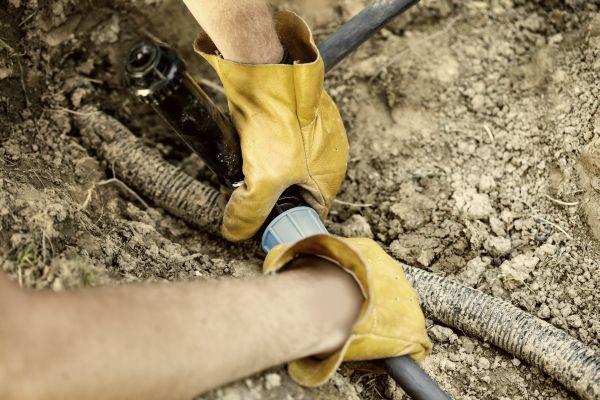Building a beautiful garden that can be maintained even during summer does not have to soak up your whole water bill. In fact, you can design a lush, water-wise oasis that will thrive even during California’s drought. Along with choosing plants that do not require significant volumes of water, using an efficient irrigation system will be your best ally in reducing your landscape’s water usage.
Moving away from older styles of irrigation
On average, 50% of summer water usage is directed to outdoor irrigation, but this does not have to be the case. There are several different types of irrigation systems. These can be broken down into low-flow and high-flow systems. The most common high-flow system, which uses more water at a higher pressure, is the classic overhead sprinkler. Its low-flow and low-pressure alternative is the drip irrigation system. Both types of systems have their pros and cons, so the decision depends on your garden and household preferences.
High-flow sprinkler systems
The traditional automatic sprinkler systems that pop up out of the ground and spray in arcs or circles are high-flow systems. They generally spray water faster than the soil can soak it up, resulting in an uneven water distribution leading to waste.
There are sprinkler heads and rotors designed to reduce water flow resulting in higher absorption and less water runoff. These can be found at irrigation distributers and some big box stores. You can also adjust your irrigation timer to irrigate for short periods of time instead of longer cycles. This allows the soil time to absorb water between irrigation cycles. For help with irrigation scheduling contact us for a free water audit at (408) 279-7900.
Low-flow sprinkler systems
Drip irrigation is a low-flow watering system that slowly delivers water to the soil instead of spraying it into the air. This kind of irrigation is used to conserve water in landscapes ranging from commercial orchards to backyard bushes. One of the most efficient kinds of drip systems is a point-source system. This system uses flexible tubing with holes designed to drip water slowly where it is needed.
A drip system can be as simple as a piece of tubing with holes punched in it, or it can be more high-tech with different types of emitters maintaining pressure and water flow. There are many different brands of drip tubing, so there is likely one type that will work best for your yard.
Drip tubing can be installed above or below the ground, depending on your landscape and family needs. If you have pets or children, above-ground drip lines might pose a tripping hazard or look like a chew toy. In these cases, underground lines may be a better choice.
No matter what kind of irrigation system you choose, you can make it even more efficient by connecting the irrigation timer to sensors that will shut the system off when it is raining and the soil is saturated. These sensors are typically wireless and can mount on a roof gutter.
Irrigation system maintenance tips
Once your irrigation system is operating, follow these suggestions to keep it in top shape and prevent any problems down the road:
- Check for leaks. A leak or break in your system will not only run up your water bill, it could also harm your plants through overwatering. Abnormally wet spots may be a sign of a leak. If you usually have your sprinkler or drip system on an automatic cycle, run it manually once a month to check for leaks, breaks or other malfunctions.
- Check for clogs. Sprinkler heads and drip emitters can become clogged resulting in uneven watering and possible harm to your plants. To check for and remove clogs, flush your system by removing the nozzles (if you have a sprinkler system) or the end caps (if you have a drip system) and running that zone for a few minutes. If one of your sprinkler heads or drip emitters is clogged, remove and clean or replace the clogged part.
- Install filters. Filters or screens will help prevent clogged sprinklers and emitters by keeping debris out.
- Make sure all of your hardware is compatible. Not all sprinkler heads will work properly with different brands. It is important to make sure you use parts that fit and operate correctly together. Using the same brand will help, however if you mix brands check that the models have similar flow rates resulting in even coverage.
By using an efficient irrigation system, you can cultivate a beautiful garden without using large volumes of water. All it takes is a little know-how and basic maintenance.
Looking to learn more about proper irrigation system maintenance? Check out San Jose Water's water conservation page here.

